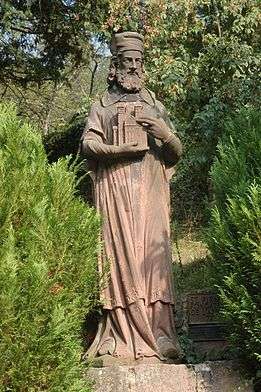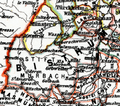Murbach Abbey
| Imperial Abbey of Murbach | ||||||||||
| Abbaye impériale et princière / chapitre collégial-équestral de Murbach (fr) Fürstabtei / Ritterstift Murbach (de) | ||||||||||
| Imperial Abbey of the Holy Roman Empire | ||||||||||
| ||||||||||
 Coat of arms
| ||||||||||
 Church of St. Leger, Murbach Abbey | ||||||||||
| Capital | Murbach Abbey | |||||||||
| Government | Theocracy | |||||||||
| Historical era | Middle Ages | |||||||||
| • | Founded by Eberhard, Count of Alsace |
727 | ||||||||
| • | Charlemagne secular abbot | from 792/3 | ||||||||
| • | Hungarian invasions | 936 | ||||||||
| • | Principality | 1228 | ||||||||
| • | Rudolph I of Germany purchased Lucerne and Unterwalden estates |
April 16, 1291 | ||||||||
| • | Suzerain to France | 1680 | ||||||||
| • | Dissolved during French Revolution |
1789 | ||||||||
| ||||||||||
| Today part of | | |||||||||
Murbach Abbey (French: Abbaye de Murbach) was a famous Benedictine monastery in Murbach, southern Alsace, in a valley at the foot of the Grand Ballon in the Vosges.
The monastery was founded in 727 by Eberhard, Count of Alsace, and established as a Benedictine house by Saint Pirmin. Its territory once comprised three towns and thirty villages. The buildings, including the abbey church, one of the earliest vaulted Romanesque structures, were laid waste in 1789 during the Revolution by the peasantry and the abbey was dissolved shortly afterwards.
Of the Romanesque abbey church, dedicated to Saint Leger, only the transept remains with its two towers, and the east end with the quire. The site of the nave now serves as a burial ground. The building is located on the Route Romane d'Alsace.
History
The founder of the abbey, Count Eberhard, brother of Luitfrid of the Etichonids, brought Bishop Pirmin from Reichenau Abbey on Lake Constance to build up the religious community, which had previously used the Rule of St. Columbanus and become ill-disciplined. Pirmin solved the difficulty by introducing the Rule of St. Benedict.
Count Eberhard gave the abbey a rich endowment and extensive privileges, including the right of free election of the abbot. The monastery was obliged to have its privileges regularly confirmed and was thus closely dependent on the Pope and the Emperor (after 1680 the King of France). Murbach was placed under the patronage of Saint Leger, who had introduced the Benedictine Rule into Burgundy in the 7th century.
The abbey was important politically, and Charlemagne himself took the title "Abbot of Murbach" (Latin: Pastor Murbacencis; in a secular sense) in 792–93.
By about 850 Murbach had become one of the intellectual centres of the Upper Rhine; the library contained about 340 works of theology, grammar and history. In its decline, the library at Murbach still provided a possible source (aside from Fulda Abbey) for Poggio Bracciolini's recovery in 1417 of Lucretius' lost didactic poem De rerum natura.[1] At the same time the worldly possessions of the abbey were increasing, thanks to large numbers of gifts. Murbach owned properties and rights in about 350 localities. Most of them were in Alsace, in the Bishoprics of Basle and Strasbourg. In addition there were properties on the right bank of the Rhine and even in the Black Forest. For example, in 805 the Alemannic nobles Egilmar, Focholt, Wanbrecht and Nothicho gave to the abbey their land and a church in the present Grissheim (Latin: villa Cressheim in pago Brisachgaginse). Further, the abbey acquired the territory of Lucerne in Switzerland and owned besides a whole series of estates in the Palatinate, near Worms and Mainz.
This first period of prosperity ended in 936 with the invasion of Alsace by Hungarians. By the 13th century the abbey had recovered and was able once again to play an important role in Alsace and the region of the Rhine.
Murbach Abbey played an important role in the creation of Switzerland. On April 16, 1291 Rudolf I bought all the rights over the town of Lucerne and the abbey estates in Unterwalden from Murbach Abbey. The Waldstätte or Forest Communities (Uri, Schwyz and Unterwalden) saw their trade route over Lake Lucerne cut off and feared losing their independence. When Rudolph died on July 15, 1291 the Communities prepared to defend themselves. On August 1, 1291 an Everlasting League was made between the Forest Communities for mutual defense against a common enemy.[2] This league formed the nucleus around which the modern country of Switzerland grew.
From the 14th century the abbey began gradually to decline in influence. In the 15th and 16th centuries Murbach was a principality, and between 1680 and 1789 was enmeshed in the tensions between the King of France and the Empire. In 1764 the monks gave up the Benedictine Rule, and the monastery became a collegiate foundation for members of the nobility (French: insigne chapitre collégial-équestral de Murbach, German: Adeliges Ritterstift Murbach). In 1789 the French Revolution and the rioting peasants gave the abbey its death blow.

Prince-Abbots
- about 1185: Conrad von Eschenbach[3]
- 1286-1298 Berchtold von Falkenstein[4]
- 1542-1570: Johann Rudolph Stoer von Stoerenberg[5]
- 1570-1587: Johann Ulrich von Raitenau
- 1587-1587: Wolf Dietrich von Raitenau
- 1587-1600: Andreas von Österreich (also Bishop of Konstanz and Brixen)
- 1600- ? : Columban van Andlau
- 1614-1625: Leopold V, Archduke of Austria (also Bishop of Passau and Strasbourg)
- 1626-1662: Leopold Wilhelm of Austria (also Bishop of Passau and Strasbourg)
- 1663-1682: Francis Egon of Fürstenberg (also Bishop of Strasbourg)
- 1681-1686: Felix Egon von Fürstenberg (Administrator)
- 1686-1720: Philipp Eberhard von Löwenstein-Wertheim-Rochefort
- 1720-1736: Célestin von Beroldingen
- 1736-1756: François-Armand de Rohan (also Bishop of Strasbourg)
- 1756-1786: Kasimir Friedrich von Rathsamhausen
- 1786-1789: Benedikt Friedrich von Andlau-Homburg (Benoît-Frédéric van Andlau-Hombourg)
See also
Gallery
 Principality of Murbach
Principality of Murbach- Late medieval tomb of Count Eberhard inside the church
 Murbach Abbey garden
Murbach Abbey garden
References
- ↑ Stephen Greenblatt, The Swerve: how the world became modern 2001:note p. 272.
- ↑ "Switzerland". Encyclopædia Britannica. 26. 1911. p. 247. Retrieved 2010-03-10.
- ↑ Wolfgang Friedrich von Mülinen: Der Oberaargau, Beiträge zur Heimatkunde des Kantons Bern, Deutschen Theils, Heft 5, Verlag von Nydegger & Baumgart, Bern, 1890. S. 80.
- ↑ Ambros Kocher: Solothurner Urkundenbuch, Erster Band 762–1245, State Chancery of the Canton of Solothurn, Solothurn, 1952. Stammtafel 2.
- ↑ Arthur Engel; Ernest Lehr: Numismatique de l'Alsace. Paris, Leroux, 1887, p 130-138.
- Philippe Legin: Die Abteikirche von Murbach im Oberelsass. Colmar, Editions S. A. E. P. Ingersheim, 1980
- Otto Feld (1961). "Zur Baugeschichte der Klosterkirche Murbach". Zeitschrift für Kunstgeschichte. Deutscher Kunstverlag GmbH Munchen Berlin. 24 (3/4): 242–49. JSTOR 1481537. doi:10.2307/1481537.
External links
| Wikimedia Commons has media related to Abbaye de Murbach. |
Coordinates: 47°55′24″N 7°09′29″E / 47.92333°N 7.15806°E
